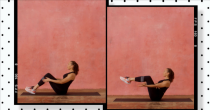Welcome to our weekly Move of the Week series. Every Monday, we’ll be sharing with you one of our favourite exercises – how to do them, what muscles they work and why they should be a regular part of your workout regime. This week: boat pose.
There are loads of great exercises out there to target your core, from planks to bird dog. But most of us rely on the same moves time and time again, repeating the same ab moves at the end of every workout.
If you’re looking to challenge your core, try adding boat pose to your repertoire. Not only does this move work your abdominals, but it will also improve your stability and strengthen your hips to injury-proof your body.
You may also like
Try dynamic 90/90 stretches to improve hip mobility
What is boat pose?
Boat pose is done seated on the floor, lifting your feet off the ground and engaging your core to stabilise the position.
The exercise is great because it:
It improves stability: you’ll have to stabilise your core to avoid wobbling as you balance your feet off the ground.
It works the deep abdominals: those are the muscles beneath the ‘six pack’ abs that are important for posture and stability.
It strengthens your hips: which is important to build power for running and strength training.
What muscles are worked in boat pose?
Boat pose is a full-body workout, but it mainly targets:
- Rectus abdominals
- Transverse abdominals
- Obliques
- Hip flexors
- Quads
You may also like
Move of the week: stretch tight shoulders with thread the needle pose
How to do boat pose
- Begin seated with your feet placed on the floor and your legs bent.
- Engage your core by pulling your belly button to your spine.
- Slowly float your feet off the floor, keeping them bent so your lower leg is parallel with the floor. As you do so, slightly lean the torso back, keeping the spine long and straight.
- Hold for 30 seconds.
For more moves of the week and fitness tips, sign up to the Strong Women Training Club.
Images: Stylist
Source: Read Full Article
